Elecampane (Inula helenium) in beautiful, frowzy bloom!
So many are struggling in my local community with coughs and chest colds or lung infections that I decided it is time to make a fresh batch of my favorite lung tonic syrup. Thankfully, everything I need is either in my garden or herb pantry and all I need to do is lift a few Elecampane and Horseradish roots to go along with the Ginger root on my counter and the golden local honey from The Crone’s Cottage. It’s mid-November now so what’s left of the above ground parts of these plants looks mainly brown and dried up, but those roots are vitally alive and full of healing energy.
Horseradish (Armoracia rusticana) and Elecampane roots fresh from the garden ready to be scrubbed & chopped.
Digging fall roots can also be a great time to gather seeds and/or divide and replant roots for next year’s needs or to share with others who might want to include these great plants in their herb gardens.
Elecampane seeds and roots
In my experience, Elecampane is easy to grow, beautiful, and carefree in the garden. It’s tall, elegant and loaded with sunny, golden blooms in July and August. That would be reason enough for me, but it also has so many health benefits to recommend it.
In my early days as an herb student, my teachers encouraged me to draw on the experience and wisdom of a wide variety of traditions and to always seek out at least three different sources---not just three different books written by the same herbalist---when researching. That became a habit that I continue to be grateful for. Now that I am sharing pages from my folk herb journals and writing a newsletter, I try to model that by the source materials I refer to. In the case of Elecampane, something about the way I was introduced to the plant resonates with Traditional Chinese Medicine (TCM).
In TCM theory organs and systems lie along meridians, have active and passive times of day, and are understood according to the five elements of Water, Wood, Fire, Earth, and Metal. That little snapshot is a gross oversimplification but TCM, like Ayurveda and other traditional healing systems, is incredibly complex. I can’t possibly do it justice in a brief newsletter. If you would like to learn more a good introduction might be CHINESE HERBAL MEDICINE by Daniel P. Reid or the wonderful new book ENERGETIC HERBALISM: A Guide to Sacred Plant Traditions Integrating Elements of Vitalism, Ayurveda, and Chinese Medicine by Kat Maier.
I was first introduced to Elecampane when I developed bronchitis for the first time in my life. I had never had a “chest cold” and I felt overwhelmed by the coughing fits, oppressive difficulty breathing, and the heavy depression that came along with this lingering condition. I had already taken two rounds of antibiotics and used a prescription inhaler to no avail. I was exhausted, frustrated, and to be honest, a little scared. I just could not seem to heal. I did something that I never recommend…I turned to an herbalist friend in desperation as a last resort. She urged me to turn to my go-to immune system supporting herbs and to add Elecampane to my protocol. I used an aggressive protocol of taking a variety of herbs in different forms hourly and within 24 hours there was definite improvement, not complete recovery but enough to show me that I was on the right path for healing.
The reason I would not recommend that approach is because it Is difficult and unfair to our wonderful herbal allies. Herbs truly shine at supporting health and helping us to be proactive about preventing dis-ease states. Do they work 100% of the time? No, but then neither do pharmaceutical medications, as I have learned painfully more than once. Waiting to use herbs as a last resort does sometimes work, as I learned in the case of my only personal experience with bronchitis, but it requires a lot of dedication, drive, and attentiveness, which is something that is often in short supply when we are ill. The old adage that ‘an ounce of prevention is worth a pound of cure’ most definitely applies to herbal healing. A cup of Chamomile tea, an Echinacea tincture, or an Elecampane syrup are not “silver bullets”, and we cannot expect them to work in the way that a powerful, pharmaceutical medication does.
So, with that big caveat to think about ways to support good health before it’s compromised, let’s proceed to extol the many virtues of Elecampane (Inula helenium). The root is the part most often used and there are multiple ways to prepare them. It has a bitter flavor but, at least to me, it is not altogether unpleasant. Even chewing a bit of the fresh root gives an expansive feeling of taking a nice, deep breath of fresh air, if you pay attention to what is happening elsewhere in your body besides on your taste buds. One of the first ways I consumed Elecampane was chopped and honeyed roots. It was simply some cleaned roots chopped into pea-sized pieces and covered with raw, local honey. A “dose” was a piece or two chewed up. I found it effective and easy to take. My kids said it tasted like tiny cubes of soap in honey. It also works well in tincture form if you don’t care for the taste, but in my experience people who need Elecampane say, “It’s not that bad.” In other words, it seems like if you need it the taste shifts from unpleasant to mildly pleasant as our bodies say YES to what the plant is providing. Just an impression.
Elecampane is a bronchodilator, hence that sense of expansion in our lungs, and it has a tonic effect on the respiratory system, breaking up mucus congestion and helping us to expectorate. That is, the cough becomes productive and the gunk gets up and out of our lungs. It has traditionally been used for bronchitis, asthma, and other chronic lung ailments. I like to use a Lung Tonic Syrup and make a fresh batch each fall, freezing it until it is needed. This is the recipe I use: ELECAMPANE LUNG TONIC SYRUP
Like Mullein (Verbascum thapsis), Burdock (Arctium lappa) and Comfrey (Symphytum officinale), both of which are said to have an affinity for the lungs, the large leaves of Elecampane are hirsute (hairy). Both the size and texture are considered to be a “signature” indicating the healing properties of these plants. Like their large leaves, they have an affinity for organs that have a large surface area, such as the lungs, skin, and intestines. These organs, as well, are concerned with gas exchange and elimination, and Elecampane helps support that in a healthy way.
In TCM the skin is called “the third lung” because when the lungs are overwhelmed in their work or congested that is often revealed on the surface of the skin in the form of rashes or redness as they struggle to detoxify and clear. Also according to that traditional system, the lungs are associated with grief and left unresolved it can lead to depression and inability to let go. I think that explains why depression is often a side effect or symptom of diseases like bronchitis and pneumonia. Even traditional Western medicine used to acknowledge that, although I don’t hear it mentioned much today.
Healthy lungs receive and let go, an exchange between inner and outer worlds. When grief blocks the exchange, it can affect lung function. Autumn is the natural season of letting go. Healthy grief---allowing yourself to freely feel what you feel---is believed (in TCM) to actually strengthen the lungs, enhancing their ability to regulate the body’s rhythms, metabolize fluids, and ultimately support immune function. I think in our modern allopathic model of medicine, we have lost sight of this holistic approach to our detriment. Our lungs bring in fresh oxygen and remove carbon dioxide. They work with the kidneys to regulate water metabolism and that supports keeping our blood clean and oxygenated.
I believe that in autumn, or during a season of grief, it is wise to choose lung supporting herbs like Elecampane. I didn’t even touch on the fact that this wonderful plant brings that same toning effect to our digestive system as well. I like to take a few drops of Elecampane Bitters before meals for this benefit, but the Lung Tonic Syrup above would serve the purpose as well.
This radiant, sunny plant that is sturdy and resilient, can look a little raggedy and frowzy, just like we sometimes feel when grieving, but it’s also warm, reassuring, a great come-as-you-are ally at a time when we need that most.

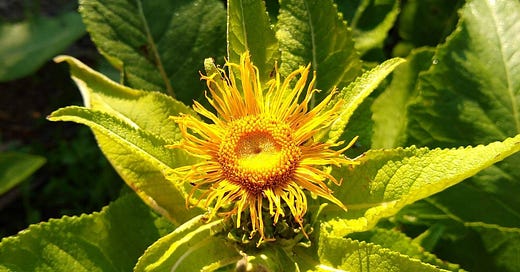




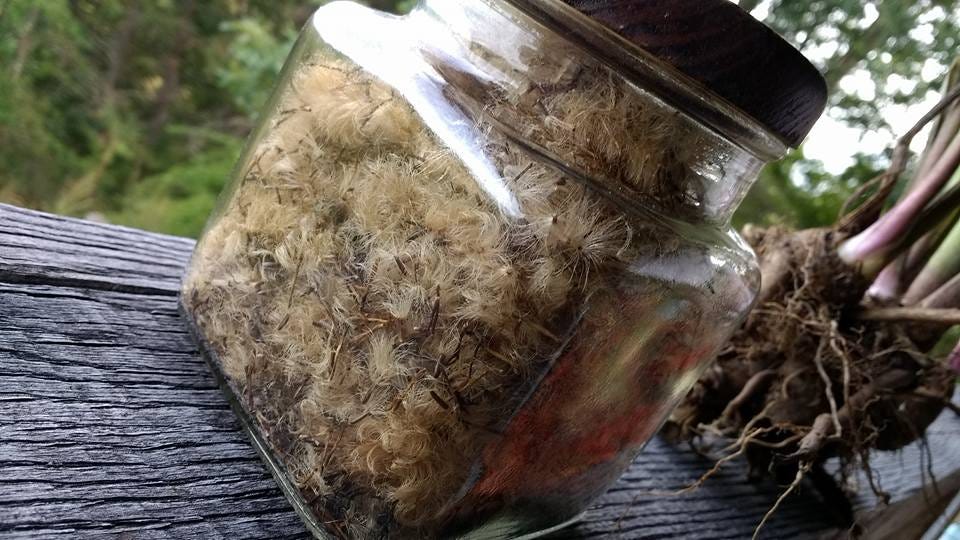
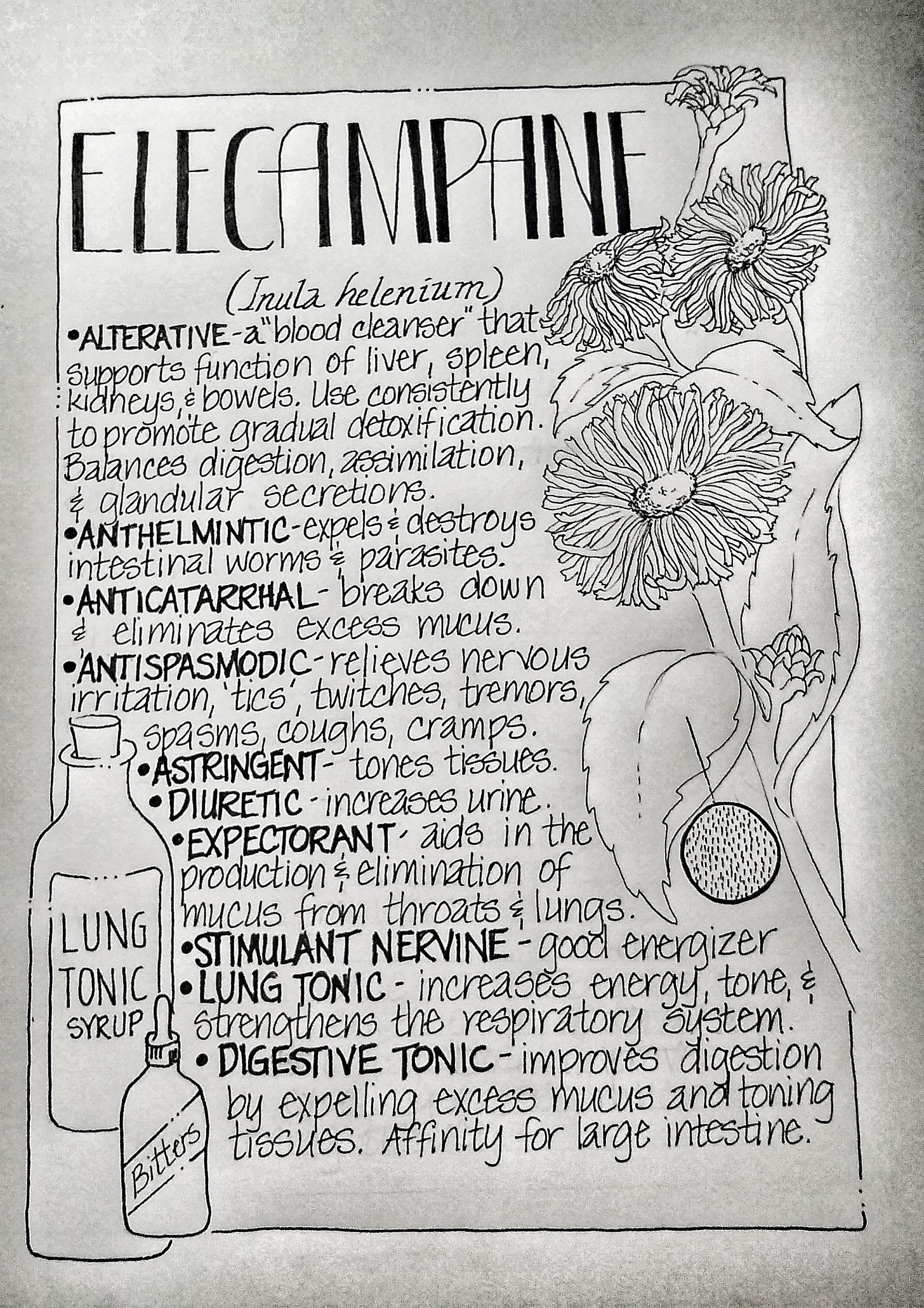
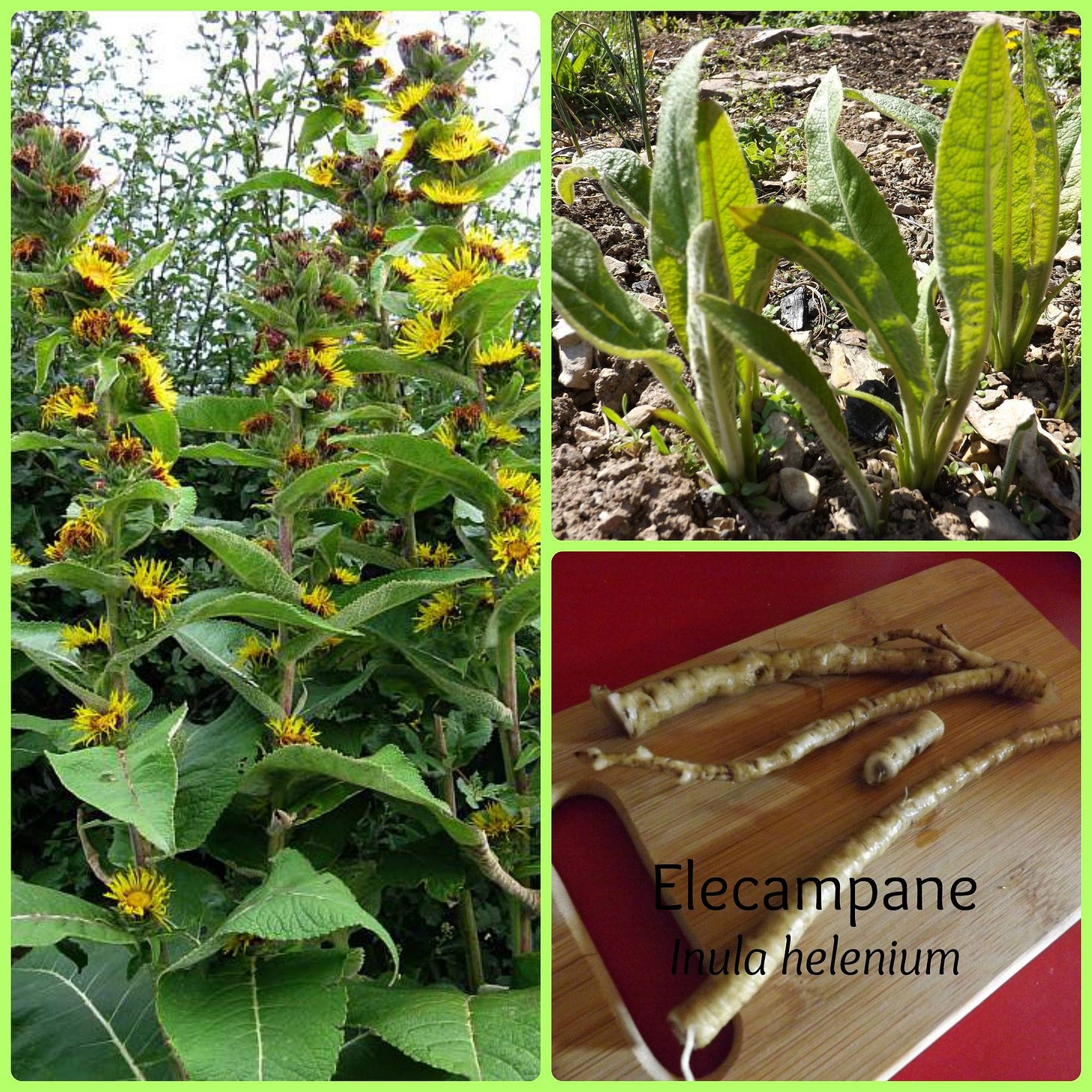
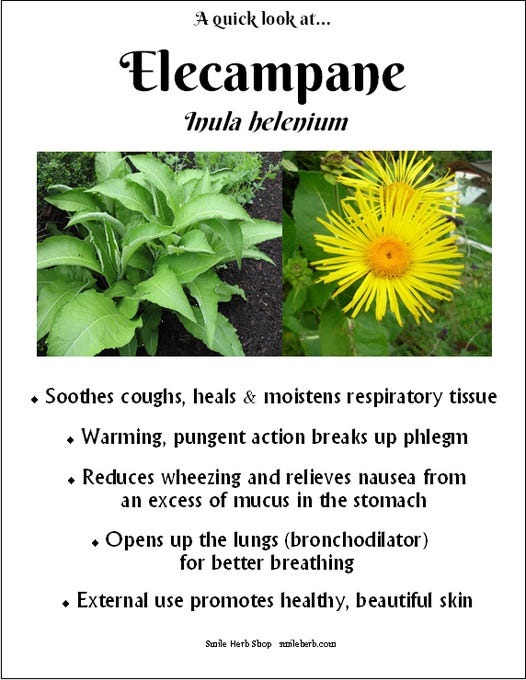
Once again I so appreciate your introduction to an herb I know of, but have never used. Love that picture of the 3 tall Elecampanes in bloom! After always turning away from horseradish as being way to strong for me, I have recently been learning how to add it in tiny amounts as a flavoring. I am quite enjoying this and it does have a good effect on my mind and body. 'Opening up' is one way to express the feeling. Now I am curious about Elecampanes! I am wondering if it might have a side benefit of deterring some critters from the garden? Even deer? That could be useful.
Thanks you, as always, appreciate your knowledge.